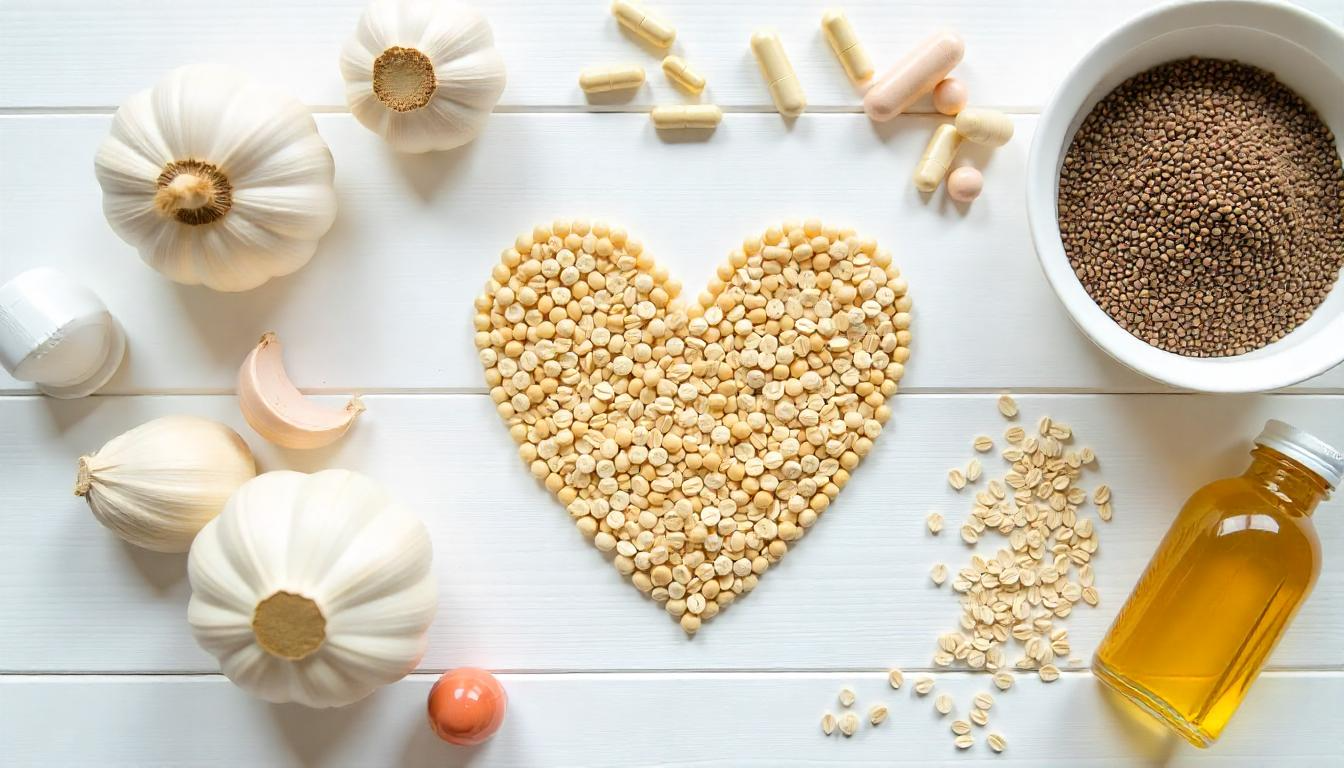Signs of high cholesterol are generally inconspicuous but can be harmful. High cholesterol sometimes has no symptoms until it causes major health issues like heart disease or stroke, making it a hidden danger that might surprise anyone. Nearly 94 million persons in America who are 20 years of age or older have total cholesterol levels more than 200 mg/dL, according to the CDC. This concerning figure emphasizes the importance of recognizing the early warning signs of high cholesterol and taking preventive measures to protect your heart.
How can you determine whether your cholesterol is rising? Your body might be trying to alert you, but a blood test is the only surefire method to find out. This article discusses seven mild yet dangerous indicators of high cholesterol, natural ways to reduce it, and the importance of taking action before it’s too late.
What is Cholesterol? A Key to Recognizing Signs of High Cholesterol
Cholesterol is a waxy substance found in your blood. Your body needs it to build healthy cells, but too much of it can increase your risk of heart disease. There are two types:
- LDL (Low-Density Lipoprotein): Known as “bad” cholesterol because it can build up in the walls of your arteries.
- HDL (High-Density Lipoprotein): Known as “good” cholesterol because it helps remove excess cholesterol from your bloodstream.
Atherosclerosis, a serious narrowing or blockage of the arteries, can result from cholesterol accumulation caused by either too high or too low HDL or LDL levels.
1. Chest Pain or Angina: A Common Sign of High Cholesterol
Angina (chest pain) is one of the most serious symptoms associated with high cholesterol. It occurs when plaque buildup in the arteries restricts blood flow to the heart, leading to chest pain or pressure.
Angina may feel like:
- Tightness or squeezing in the chest
- Pain that radiates to the arms, neck, jaw, or back
- Shortness of breath during physical activity
Get medical help right away if you’re having these symptoms. This can indicate that coronary artery disease is present.
2. Yellowish Deposits Around Eyes: Visible Signs of High Cholesterol (Xanthelasma)
Are there gentle, yellowish areas surrounding your eyelids? On their own, these fatty deposits, known as xanthelasma, would not be harmful, but they are frequently connected to elevated cholesterol.
They should not be disregarded since they may be an obvious sign of high LDL cholesterol. During a standard examination, a dermatologist might spot them and suggest a cholesterol test
3. Numbness or Tingling: A Possible Sign of High Cholesterol
Numbness or tingling in the hands and feet might result from poor blood flow brought on by clogged arteries. This symptom, which is frequently disregarded or confused with another illness, may indicate that your blood circulation is impaired.
Plaque-clogged arteries can prevent enough oxygen-rich blood from reaching your extremities. Even in warm weather, this can result in freezing hands and feet.
4. Fatigue or Shortness of Breath: Overlooked Signs of High Cholesterol
Although fatigue is a broad symptom that can signal a variety of conditions, when paired with other symptoms listed above, it may be an indication of decreased oxygen delivery due to blocked or restricted arteries.
You might:
- Struggle to climb stairs without getting winded
- Feel constantly tired without a clear reason
- Need frequent breaks during mild activity
These signs warrant a discussion with your doctor, especially if you’re at risk for cardiovascular disease.
5. High Blood Pressure: A Common Sign of High Cholesterol
High blood pressure frequently coexists with high cholesterol, even though it is not a sign in and of itself. Plaque accumulation causes arteries to narrow, making it harder for the heart to pump blood, which raises blood pressure.
Unchecked high blood pressure can damage your arteries further, creating a vicious cycle of cardiovascular strain.
Quick Tip:
If your blood pressure is consistently over 130/80, talk to your healthcare provider about getting your cholesterol checked as well.
Learn about the top 10 symptoms of high blood pressure you should never ignore for a deeper understanding of how it can affect your health.
6. Slurred Speech or Sudden Dizziness: Serious Signs of High Cholesterol
These could be early warning indicators of a stroke in addition to being indicators of excessive cholesterol. A stroke could result from blood flow obstruction caused by a broken cholesterol plaque that makes its way to the brain.
Look out for the FAST warning signs:
- Face drooping
- Arm weakness
- Speech difficulty
- Time to call emergency services
Get help right away if you or someone you know exhibits these symptoms. Early intervention can prevent high-cholesterol-related strokes.
7. Leg Pain When Walking (Claudication): A Key Sign of High Cholesterol
Walking-related leg pain or cramping could be an indication of peripheral artery disease (PAD), a disorder in which the limbs’ blood flow is reduced by constricted arteries. High cholesterol is frequently the cause of PAD, which can be an early warning sign for more serious heart problems.
Symptoms of PAD include:
- Pain in calves, thighs, or hips during activity
- Pain that goes away with rest
- Coldness in one lower leg or foot
PAD can increase your risk of heart attack and stroke, so it’s vital to take it seriously.
How to Lower High Cholesterol Naturally
Managing cholesterol doesn’t always require medication—lifestyle changes can be incredibly effective. Here’s how:
1. Eat Heart-Healthy Foods
- Increase soluble fiber (oats, legumes, fruits)
- Reduce saturated fats (red meat, full-fat dairy)
- Eliminate trans fats (processed foods)
- Add omega-3 fatty acids (salmon, flaxseeds, walnuts)
2. Get Regular Exercise
On most days of the week, try to get in at least 30 minutes of moderate exercise. Exercises that increase HDL (good) cholesterol include swimming, cycling, and walking.
3. Quit Smoking
Smoking raises your risk of heart disease and reduces your HDL. You can rapidly enhance your circulation and cholesterol levels by quitting.
4. Consider Natural Supplements
Sea moss is one superfood that is gaining popularity because it includes omega-3 fatty acids and antioxidants that may help cardiovascular health.
Learn how sea moss may help manage cholesterol here.
Frequently Asked Questions (FAQs)
Q1: What are the normal cholesterol levels?
- Total cholesterol: Less than 200 mg/dL
- LDL (bad cholesterol): Less than 100 mg/dL
- HDL (good cholesterol): 60 mg/dL or higher is optimal
Q2: Can high cholesterol cause symptoms?
High cholesterol typically doesn’t show any signs until it leads to issues like heart disease or stroke. Regular screening is therefore essential.
Q3: How often should I check my cholesterol?
Every four to six years, adults over 20 should have their cholesterol checked; however, those who have risk factors (such as obesity or a family history) may require more frequent testing.
Q4: Can sea moss lower cholesterol?
Yes. Sea moss contains soluble fiber, antioxidants, and omega-3s, which may help reduce LDL cholesterol levels. Read the full article here.
Q5: Is medication always necessary?
Not all the time. Although diet, exercise, and lifestyle modifications can help many people control their cholesterol, doctors occasionally recommend statins or other drugs.
Conclusion: Listen to Your Body – Recognize the Signs of High Cholesterol Before It’s Too Late
Although silent most of the time, high cholesterol is not invisible. Fatigue, leg pain, yellow spots around the eyes, or more serious problems like angina or dizziness are all early signs of high cholesterol — warning indications your body gives before a major issue occurs. By paying attention to these symptoms, you have the opportunity to act before irreparable harm is done.
The good news? You can lower and even reverse high cholesterol naturally through diet, exercise, and smart lifestyle choices. Add fiber-rich foods, omega-3s, and heart-healthy superfoods like sea moss to support cholesterol balance and cardiovascular health.
👉 Stay informed, listen to your body, and share this post to help others recognize the signs of high cholesterol before it’s too late.
Take Action Now:
- Schedule a cholesterol test
- Review your diet and lifestyle
- Incorporate heart-healthy superfoods like sea moss
- Share this article with friends and family
Your heart deserves the best care, and that starts with awareness.



